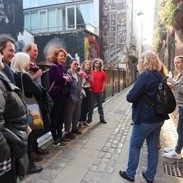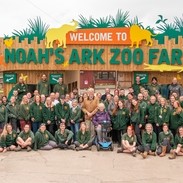Accessible and inclusive tourism
section 1
These reports explore how those with health impairments plan travel, what their accessibility needs are and why some are choosing not to travel.
In partnership with third parties, we have looked at what types of accessibility requirements are needed by our inbound travellers. We also carried out a survey to ask businesses about issues they face in providing for guests with accessibility needs and what could help them.
For further information, please contact [email protected] .
Inbound visitors to the UK with a health condition or impairment (2023)
Report highlights
- In 2023, 724,000 trips or 1.9% of the all inbound overnight visits to the UK were taken by those with a health condition or impairment or travelling within a group where a member had a health condition or impairment.
- The total expenditure generated by those visits is estimated to be £624 million, or 2.0% of all inbound visitor spending in 2023.
- In 2023, the number of visits with impairments is 5% below the level in 2018 (total inbound visits were 6% below).
- When compared to total inbound visits, visits with a health condition or impairment lasted longer on average and the average spend per visit was higher, while average spend per night was smaller.
- The smaller average spend per night is due to visits with impairments being more likely, than all inbound visits, to be visiting friends or relatives, which tend to be longer and cost less.
View the report
Inbound visits with impairments_2023.pdf
View this report.
Key accessibility features
Report highlights
- The list of accessibility features requirements is complex and often needs to cover a wide range of requirements. Travel groups are typically looking to meet the accessibility needs of multiple people with multiple impairments, each with very specific requirements.
- Wheelchair use has the most profound impact on accessibility features/support requirements.
- Information about accessibility presents a barrier to participation.
- More detail is often required to clarify exactly what the feature comprises. [This can be included within an Accessibility Guide]
- Priority features differ for each business-type, however, accessible parking, accessible toilet and lifts (where applicable) are typically minimum critical requirements.
- In addition to the priority features which meet the needs of the majority, there are features important to minority groups. [These could be included in a more detailed list in pursuit of more comprehensive inclusivity.]
View the report
Accessibility Features Research_Summary report.pdf
View the full findings.
The value of the Purple Pound (2023/2018)
Here, we estimate the volume and value of the accessible tourism market in England. The data is taken from the following three surveys: Great Britain Day Visitor Survey (July 2022 to June 2023), Great Britain Tourism Survey (July 2022 to June 2023) and International Passenger Survey (2018).
Report highlights
- The total travel expenditure generated by those with a health impairment or travelling in a group where a member had a health impairment is estimated to be £14.6 billion annually
- This figure breaks down as £0.5bn from inbound, £6.7bn domestic overnight and £7.4bn domestic day visits.
- The spend from trips taken by those with an impairment and their travelling companions made up 2.2% of all inbound trip spending in England in 2018, 24% of domestic overnight trip spending and 18% of day visit spending in England in the 12 months to June 2023.
View the report
Find out more about the value of the Purple Pound.
MIDAS project: Accessibility & Inclusiveness (2022)
Report highlights
- One in four travellers, or their companions, travel with a health impairment, the most prevalent of which are hearing/vision impairment and mental health.
- Northern Europe, South Asia and North America have the highest penetration of those with accessibility tourism needs.
- Britain is seen as one of the more inclusive and accessible countries, amongst travellers with accessibility requirements.
View the report
MIDAS - Accessibility & Inclusiveness.pdf
View the full findings
The National Accessible Scheme Review Consumer Research (2022)
Report highlights
- The booking and planning journey is influenced by multiple, complex factors, and driven by researching facts and opinion to inform a personal choice.
- Accommodation is just one part of the overall decision-making process, all of which are impacted by having a health condition. Often the accommodation search doesn’t start until the other elements (surrounding area, attractions, amenities) are considered.
- Most holiday-makers think about accommodation features, rather than specific health conditions or disability categories: “Don’t tell me what I want, tell me what you have and I’ll make my decision”.
View the report
Accessibility Consumer Research Report 2022.pdf
Accessibility Consumer Research Report 2022
Project Accessible - North York Moors (2021)
- Phase 1 - quantitative research, focused on the customer journey and holiday behaviour of German and Dutch Explorers with an accessibility requirement. Read the research report (PDF, 6.14 MB).
- Phase 2 - qualitative research, focusing on the testing of the proposed itineraries to establish their appeal and suitability for the target group. Read the research report (PDF, 9.88 MB).
Report highlights
- While those with health impairments differ on their travel requirements, their motivations are similar: to feel relaxed, switch off and experience great food and drink.
- Explorers with health impairments are not heavy travellers and are expecting to travel to one country each year for the next three years.
- They spend one month or less planning their trip and take up to six months to book their trip.
- They tend to book their trips on the destination website, or directly through accommodation providers or with tour operators.
View the reports
Project Accessible report 1.pdf
North York Moors Accessibility Project
Project Accessible: Phase 2
Qualitative research, focusing on the testing of the proposed itineraries to establish their appeal and suitability for the target group.
Inbound visitors to the UK with a health condition or impairment (2018)
Report highlights
- 759,000 trips or 1.9% of the total inbound overnight visits to the UK in 2018 were taken by those with a health impairment or travelling within a group where a member had a health impairment.
- The total expenditure generated by those visits is estimated to be £552 million, or 2.1% of all inbound visitor spending in 2018.
- Since 2010, inbound visits in 2018 from those with a health impairment have grown significantly: up 16% in volume and up 42% in value.
- In 2018, growth in visitors requiring a wheelchair saw the biggest rise - up 136% since 2010.
- Those with a health condition and their travelling group are more likely to stay for longer and spend more than the UK inbound average.
View the report
Inbound visitors to the UK with a health condition or impairment.pdf
Inbound visitors to the UK with a health condition or impairment
Accessibility: Non-Participation in Tourism (2018)
Report highlights
- In 2018, 19% of the GB population had a health impairment, and the most common was a long-term illness.
- Those with a health impairment were less likely to have taken a holiday in England in the previous 12 months (48%) than those without a health impairment (64%).
- 51% of people who identify as disabled did not take a holiday in England in the last 12 months that involved staying away from home for one night or more (compared to 40% of non-disabled people).
- Long domestic holidays (4+ nights) were the most common type of trip for those with a health impairment.
- The top reason for not taking holiday in the past 12 months was not being able to afford it (stated by 33% of those with a health impairment).
- 15% could not go away due to ill-health and 8% due to lack of provision for accessibility needs.
View the report
Accessibility – Non Participation.pdf
Accessibility – Non Participation
National Survey on Accessibility Provision (2015)
Report highlights
- 30% of establishments were accessible at the time (‘accessible’ was defined as having a step-free access and at least one room for wheelchair users).
- Nearly two thirds (63%) of businesses which provide for accessibility needs say they do not promote the fact that they do.
- A theme throughout the interviews was that many operators seemed to think instantly of ‘mobility needs’ when the term ‘accessibility needs’ was mentioned.
- The most common form of provision is designated accessible parking spaces found in 50% of establishments. 37% have large print information. And only 21% of establishments provided staff training with respect to welcoming guests with accessibility needs.
View the report
National Survey on Accessibility Provision.pdf
National Survey on Accessibility Provision






